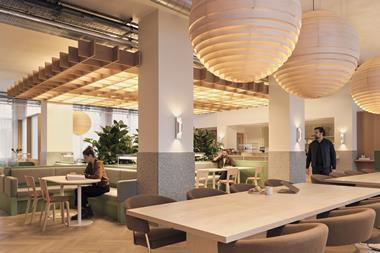Four months ago, the majority of the UK packed up their desks, left the office and began working from home. Speculation around what life beyond lockdown will mean for the office sector has been rife ever since.

It is widely acknowledged that, post-lockdown, working from home will jump structurally and significantly, with little recognition for how the office has successfully facilitated business for over 300 years.
With everyone working from home, digital connectivity over the past few months has become a crucial lifeline for individuals and businesses alike. The plethora of video conferencing facilities has allowed for collaborative and constructive communication in a remote setting. Arguably, this has been most effective for those who had already developed face-to-face relationships pre-Covid. In the longer term, how detrimental might a wholesale reliance on technology for communication be to a company culture, its community and brand?
That’s not the only question to consider: how do we facilitate peer-group learning and career development on a purely virtual platform? What will be the impact on creativity and productivity without, for example, incidental interactions that you get outside of a formal meeting? Without an office space, what’s the perception of a business’s stability, and a company culture that’s needed to win business and recruit and retain staff?

In 2017, Nicholas Bloom, a Stanford economist and leading researcher into home working, conducted an experiment. Working with a Chinese company and its 1,000 employees, half of the workforce volunteered to work from home. After nine months, 250 had returned to work – choosing a 40-minute commute over days of feeling lonely and overlooked at home.
The speed of the flex-market expansion demonstrates there is no one-size-fits-all proposition for businesses, which is why we have seen the office sector mature into what it is today. The most likely outcome post-Covid will be an increase in flexible working.
The pandemic has accelerated an existing trend, as opposed to imposing a structural shift.
In the short term, we may see a dip in demand in office space, but as the economy recovers, this is likely to be offset by businesses seeking to improve the office experience.
Short-term leases
The case for short-term office leases in a slower economic environment is compelling. In order to maximise demand, the serviced-office market needs to create safer and more comfortable working environments. Office density levels need to be reduced by half: from the typical ratio of one person for every 4 or 5 sq m to the levels air-conditioning systems are designed to service – typically 1:8 sq m or 1:10 sq m. The challenge will be how to achieve this while remaining financially viable.
The entrepreneurial spirit adopted by many in the serviced space has shown it to be agile enough to find a solution to such challenges. While the sector will need to consolidate and evolve, the operators that survive and offer a point of difference will come back stronger and more resilient.
Legal & General’s Capsule flexible leasing office densities are typically one person to every 8 or 10 sq m, and increasingly include sensors that measure air quality, temperature and humidity. We have also installed personal temperature checks via thermal-imaging technology. This will become more important in the coming months as our offices are reoccupied, to reduce the risk of infection through the use of technology and good estate-management practice.
Creating safe environments is obvious, but landlords will also need to put equal focus on a high level of service and occupier experience if they are to tempt workers back to the office. As they have always done, offices will continue to be a vital facilitator of creativity and productivity and an important piece of the urban puzzle, supporting footfall and spending. These are the ingredients needed to restart the economy.
Andrew Mercer is office sector lead at LGIM Real Assets






























No comments yet